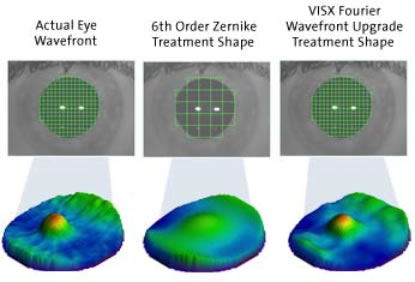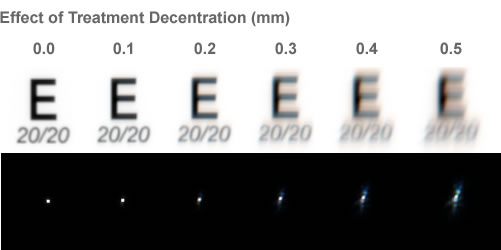Compare Vision Correction Lasers
| Feature | Benefit | VISX Star S4 IR | WaveLight Allegretto | Bausch and Lomb | Alcon LadarVision | Nidek EC 5000 |
|---|---|---|---|---|---|---|
| USA Market Share* | Reflects Surgeon Preference | 67% | 18% | 7% | 6% | 2% |
| Custom Wavefront Technology | Greater clarity Better night vision |
Yes | Yes - limited range | Yes - limited range | Yes - limited range | No |
| Fourier Algorithm | Allows highest resolution of wavefront data | Yes | No | No | No | No |
| 3-D eye tracking | Compensates for eye movement during treatment | Yes | No | No | No | No |
| Iris Registration | Ensures that each laser spot is placed at the optimal location | Yes | No | No | No | No |
* 2008 American Academy of Ophthalmology / International Society of Refractive Surgery Annual Survey
USA Market Share - Vision correction lasers are enormously expensive, with prices exceeding $400,000 – so surgeons must carefully judge the merits of each platform before making an investment. Their verdict? The VISX Star S4 IR laser system is preferred by a wide margin, despite having the highest overall cost of operation.
Custom wavefront technology - When compared to conventional treatments, custom wavefront treatments enhance clarity and improve night vision, night driving performance and the ability to see contrasts. However, you may not qualify for a custom treatment if your prescription is outside of the FDA-approved range of your Phoenix LASIK surgeon's laser. Because the VISX Star S4 IR has the widest approval range, it offers you the highest likelihood of qualifying for an advanced custom treatment.
Fourier algorithm - The quality of a custom treatment depends on the resolution of the wavefront data provided to the laser - the higher the resolution of the wavefront data, the higher the resolution of the treatment.
Raw wavefront data is obtained by measuring the eye with a wavefront analyzer. Sophisticated mathematical formulas are necessary to convert the raw data into the complex 3-dimensional maps that guide the laser. The VISX wavefront system is the only one that uses a mathematical technique known as Fourier reconstruction to convert the raw data. The others all use Zernicke Polynomials. As illustrated below, the Fourier technique provides the highest resolution, a finding that has been formally substantiated by a study out of Baylor University.

3-D eye tracking – Do you wonder what might happen if your eye moves during treatment? Fortunately, all current laser systems feature trackers- cameras that monitor the position of your eye and reposition the laser accordingly. However, only the VISX Star S4 IR monitors movement in all three dimensions. If your eye moves left, right, up or down, then all systems will track the movement. But, if your eye moves in the 3rd dimension – closer to the laser or farther away – only the VISX laser will track this movement.
Iris registration – Iris registration (IR) is easily the most unique advantage of the VISX laser. In essence, IR insures that each laser spot is placed at exactly the right location on the eye.
The basic principle behind iris registration is quite simple. When the preoperative wavefront measurement is taken, the eye is simultaneously photographed and landmarks on the iris (the colored part of the eye) are identified by the IR software. Then, right before the laser treatment, another picture of the eye is taken by a camera in the laser. The iris landmarks are again identified and treatment is registered to the proper location on the eye.
By identifying iris landmarks and registering the treatment, two goals are accomplished. First, the treatment is precisely centered on the eye. And second, compensation is made for any clockwise or counter-clockwise rotation of the eye.


Prior to IR, no effective means was available to compensate for mild treatment decentration, and the surgeon had to manually compensate for rotation of the eye by rotating the patient's head - a method much less precise than IR's ± 0.5 degree tolerance.
Laser System Summaries
VISX Star S4 IR – VISX is the American company that invented laser vision correction in 1986. With every major technological advancement available today including custom-wavefront driven treatments, Fourier reconstruction of wavefront data, 3-dimensional eye tracking, and the only available system of automated registration to insure that each laser spot is placed at precisely the right location, the flagship VISX Star S4 IR laser continues to lead the industry in technological innovation and physician preference.
The WaveLight Allegretto is currently in second place behind VISX. It is a well-respected, German-made laser that appeals to many Arizona LASIK surgeons because its per procedure royalty fee is lower than most of the competition and because it offers a “wavefront optimized” treatment mode that can approximate the results of a true wavefront-driven custom treatment with less work. However, the Allegretto does not offer Fourier reconstruction, it only offers 2-dimensional eye tracking and it does not offer any form of automated registration to precisely align the treatment. Furthermore, a comparative study recently showed that VISX Star S4 IR custom-wavefront treatments reduce visual aberrations better than the Allegretto's wavefront optimized mode. Consequently, the Allegretto remains a distant second to VISX.
Bausch and Lomb – The B&L laser was quite popular overseas in the 1990's. However, it was slow in obtaining FDA approvals and lacks the latest technological innovations, most notably automated registration. With the large lead held by VISX and the current status of the WaveLight Allegretto as the preferred alternative, it is unlikely that the B&L laser will play more than a small role in the future.
Alcon LadarVision – Alcon's LadarVision went head-to-head with VISX through the mid to late 1990's until VISX ultimately won out. For a time, LadarVision also had an advanced method for registration, but the system was recalled by the FDA for performance issues. This was a significant setback for the LadarVision platform and perhaps the main reason that Alcon recently purchased the WaveLight company. Consequently, most LadarVision lasers are now being replaced by WaveLight Allegretto systems.
NIDEK – The NIDEK EC 5000 is the only commonly used laser that lacks custom-wavefront technology. As such, it occupies the bottom rung on the technology ladder. Since NIDEK is the only laser company that does not charge a per-procedure royalty fee, its lasers are found almost exclusively in corporate discount chains that drive patient volume through cut-rate pricing. However, with no custom-wavefront technology, limited implementation of 2-D eye trackers, and no automated registration, patients who desire premium quality must look elsewhere.
Frequently Asked Questions about Laser Features
(click a question to view answer)There are currently no questions for this section. You can ask a question by filling in the form here.
